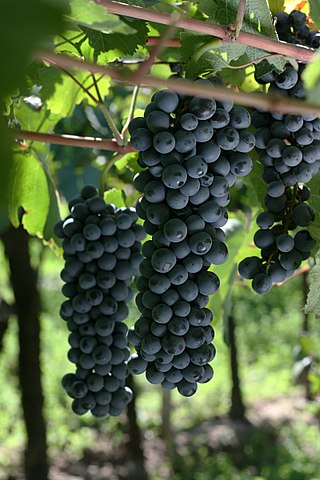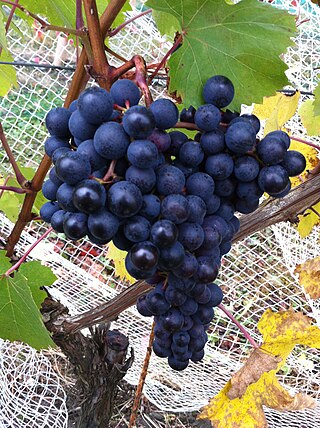
Nebbiolo is an Italian red wine grape variety predominantly associated with its native Piedmont region, where it makes the Denominazione di Origine Controllata e Garantita (DOCG) wines of Barolo, Barbaresco, Gattinara, Ghemme, and Roero, together with numerous DOC wines. Nebbiolo is thought to derive its name from the Italian nebbia or Piedmontese nebia, meaning 'fog'. During harvest, which generally takes place late in October, a deep, intense fog sets into the Langhe region where many Nebbiolo vineyards are located. Alternative explanations refer to the fog-like glaucous veil that forms over the berries as they reach maturity, or that perhaps the name is derived instead from the Italian word nobile, meaning 'noble'. Nebbiolo produces lightly-colored red wines which can be highly tannic in youth with scents of tar and roses. As they age, the wines take on a characteristic brick-orange hue at the rim of the glass and mature to reveal other aromas and flavours such as violets, tar, wild herbs, cherries, raspberries, truffles, tobacco, and prunes. Nebbiolo wines can require years of ageing to balance the tannins with other characteristics.

Barbera is a red Italian wine grape variety that, as of 2000, was the third most-planted red grape variety in Italy. It produces good yields and is known for deep color, full body, low tannins and high levels of acidity.

Vermentino is a light-skinned wine grape variety, primarily found in Italian wine. It is widely planted in both Sardinia and Liguria, to some extent in Corsica, in Piedmont under the name Favorita, and in increasing amounts in Languedoc-Roussillon. The leaves are dark green and pentagonal. The grapes are amber-yellow and hang in pyramidal bunches. The vines are often grown on slopes facing the sea where they can benefit from the additional reflected light. The Vitis International Variety Catalogue now gives Italy as its origin.

Piedmont wine is the range of Italian wines made in the region of Piedmont, in the northwestern corner of Italy. The best-known wines from the region include Barolo and Barbaresco. They are made from the Nebbiolo grape. These wines are ideal for storage and a well-aged Barolo for instance may leave a feeling of drinking velvet because the tannins are polished and integrated more and more into the wine. As the wine matures the colour becomes more brownish and rust-red.

Tuscan wine is Italian wine from the Tuscany region. Located in central Italy along the Tyrrhenian coast, Tuscany is home to some of the world's most notable wine regions. Chianti, Brunello di Montalcino and Vino Nobile di Montepulciano are primarily made with Sangiovese grape whereas the Vernaccia grape is the basis of the white Vernaccia di San Gimignano. Tuscany is also known for the dessert wine Vin Santo, made from a variety of the region's grapes. Tuscany has forty-one Denominazioni di origine controllata (DOC) and eleven Denominazioni di Origine Controllata e Garantita (DOCG). In the 1970s a new class of wines known in the trade as "Super Tuscans" emerged. These wines were made outside DOC/DOCG regulations but were considered of high quality and commanded high prices. Many of these wines became cult wines. In the reformation of the Italian classification system many of the original Super Tuscans now qualify as DOC or DOCG wines but some producers still prefer the declassified rankings or to use the Indicazione Geografica Tipica (IGT) classification of Toscana. Tuscany has six sub-categories of IGT wines today.

Arneis is a white Italian wine grape variety originating from Piedmont, Italy. It is most commonly found in the hills of the Roero, northwest of Alba, where it is part of the white Denominazione di Origine Controllata e Garantita (DOCG) wines of Roero. It can also be used to produce DOC wines in Langhe. Arneis is so called because it is regarded as a somewhat difficult variety to grow. It is a crisp and floral varietal, and has been grown for centuries in the region. The white wines made from the Arneis grape tend to be dry and full bodied with notes of pears and apricots.
Barbarossa is the name of several red/pink colored Italian wine grape varieties. At one point the French wine grape Barbaroux was thought to also be a Barbarossa grape but DNA evidence published in 2009 confirmed that the French Barbaroux grown in Provence was a separate variety distinct from, at least, the Barbarossa grapes grown in Piedmont and Liguria. Further research is still being done map out the exact relation among all the Barbarossa varieties in Italy and with the Barbaroux grape grown in Corsica.
Erbaluce or Erbaluce bianca is a white Italian wine grape grown primarily in the Piedmont region around Caluso, in Canavese. In addition to dry table wines, it is used to make sweet wines with deep golden coloring, such as passito. The grape has a long history in the Piedmont region, with the first written record dating to 1606, and most likely originated in the alpine hills of northern Piedmont.
Uva Rara is a red Italian wine grape variety that is grown in the Piedmont and Lombardy wine regions of northern Italy. The grape is a permitted blending variety along with Nebbiolo in the Denominazione di Origine Controllata e Garantita (DOCG) wines of Ghemme. In the Denominazione di Origine Controllata (DOC) wine region of Oltrepò Pavese the grape is often blended with Barbera and Croatina. While Uva Rara's name means "rare grape" in Italian, the variety is actually widely planted with 608 hectares of the vine recorded in Italy in 2000.
Vespolina is a red Italian wine grape variety that is planted in Piedmont around Gattinara and Ghemme. Ampelographer believe that the grape is most likely indigenous to this area of Piedmont and recent DNA profiling identified a parent-offspring relationship with Nebbiolo. Outside Piedmont it is found in the Lombardy region of Oltrepò Pavese where the grape is known as Ughetta. In Gattinara, Vespolina is sometimes blended with Nebbiolo and Bonarda Piemontese. Unlike the white Italian grape Vespaiolo, the root of the name Vespolina does not have a direct connection with vespe or wasp. However the true origins of the name are still unclear.
Rossola nera is a red Italian wine grape variety that has been growing in the Valtellina region of Lombardy since at least the 17th century. In 2004 DNA profiling determined that the grape has a parent-offspring relationship with the Piedmont wine grape Nebbiolo though which variety is the parent and which is the offspring is not yet clear. However, most ampelographers believe that Nebbiolo is likely the parent variety since written records in Piedmont have noted Nebbiolo being grown since at least the 13th century.
Canari noir is a red French wine grape variety that has been historically grown in the Ariège department in the foothills of the French Pyrénées. However DNA profiling in 2001 showed that plantings of a grape called Gamay Luverdon growing in the Italian wine region of Piedmont were in fact plantings of Canari noir. Across the Pyrénées in Spain, the grape variety known as Batista was also found to be identical to Canari noir. Like Pinot noir and Grenache, Canari noir has color mutations known as Canari blanc and Canari gris.

Douce noir is a red Savoyard wine grape variety that has historically been grown in the Savoy region, but today is more widely planted in Argentina.

Vermentino nero is a red Italian wine grape variety that is predominantly grown in province of Massa-Carrara in Tuscany. After World War II, the vine was almost lost to extinction until Podere Scurtarola, a producer from Massa, began replanting old vineyards with the grape. By 2000, there were 199 hectares of Vermentino nero growing in Italy with the grape authorized for production in the Denominazione di origine controllata (DOC) wines of Candia dei Colli Apuani and Colline Lucchesi.
Barbera bianca is a white Italian wine grape variety that is grown in the Piedmont wine region of northwest Italy. Despite being named Barbera bianca, the grape is not a color mutation of the red Piedmontese wine grape Barbera that is the third most widely planted grape variety in Italy. In fact, DNA analysis conducted in the early 21st century shows no genetic relationship at all between the two grape varieties.
Grisa nera is a red Italian wine grape variety that is grown in the Piedmont wine region of northwest Italy where it is used in both winemaking and as a table grape. The grape is most often used as a minor blending component with wines made from Barbera, Neretta Cuneese and Plassa.

Valentino nero is a red Italian wine grape variety that is grown in the Piedmont wine region of northwest Italy but was initially bred at the Conegliano research center in the Veneto. In 1936, its creator, Giovanni Dalmasso, stated that the grape was a crossing of two Vitis vinifera Piedmontese varieties, Nebbiolo and Dolcetto, but DNA profiling in 2009 showed that the French wine grape Chatus and Dolcetto were the parent vines.

Luglienga is a white Italian wine and table grape variety that is grown across Europe. The grape has a long history of use, dating back to at least the 14th century in Piedmont but is today most seen a table grape that is occasionally used for home winemaking.
Avanà is a red Italian wine grape variety that is grown in the Piedmont wine region of northwest Italy. Historically, the grape has also been grown in the Dauphiné and Savoie wine region of eastern France where it was known as Hibou noir and in the Valais region of Switzerland. The grape is most often used as a blending variety in the Denominazione di origine controllata (DOC) zones of Pinerolese, with Barbera, Persan, Freisa and Neretta Cuneese, and Valsusa, with Barbera, Dolcetto, Neretta Cuneese and other local red Piemontese varieties.
Avarengo is a red Italian wine grape variety that is grown in the Piedmont wine region of northwest Italy where it is a permitted blending component in the Denominazione di origine controllata (DOC) wines of Pinerolese. Here the grape is usually blended with Avanà, Neretta Cuneese and other local red Piemontese varieties.










